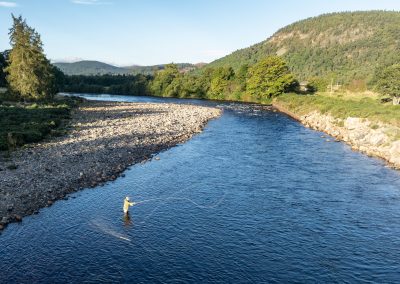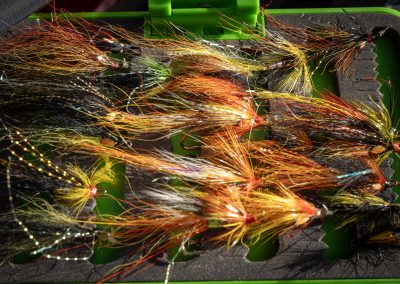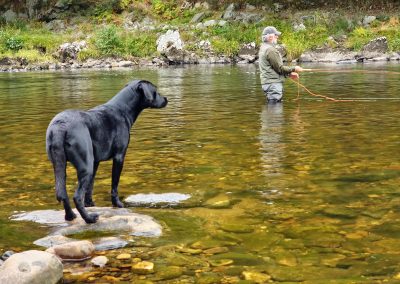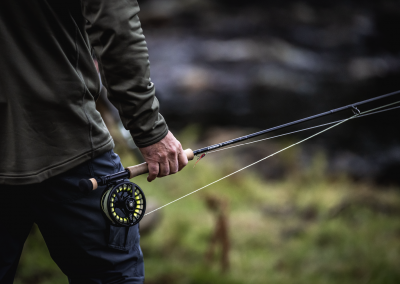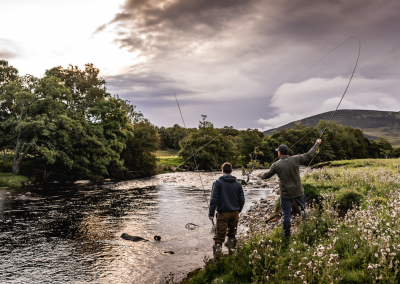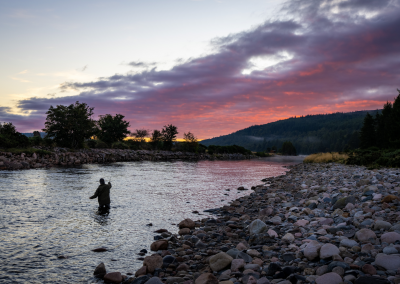Atlantic Salmon
Atlantic Salmon
Fly Fishing For Atlantic Salmon
Atlantic Salmon And The Macnab Challenge
The Scottish Atlantic salmon, Salmo salar, is a creature of immense allure and profound ecological significance, often referred to as the “King of Fish.” Its epic life cycle, spanning both freshwater rivers and the vast Atlantic Ocean, embodies the wild, untamed spirit of Scotland’s aquatic environments. For the dedicated angler, the pursuit of this magnificent fish in the pristine rivers of Scotland, under the expert guidance of an estate Ghillie, offers an experience deeply rooted in tradition and unparalleled in its challenge and reward.
Habitat: An Epic Journey
The Atlantic salmon’s life begins in the gravelly redds (nests) of clear, cool, and oxygen-rich Scottish rivers. These are the spawning grounds, often located in the upper reaches of catchments, where the adult salmon have journeyed thousands of miles to reproduce. After hatching, the tiny fish, known as alevins, remain in the gravel, absorbing their yolk sacs. They then emerge as fry, growing into parr over one to three years, identifiable by their distinctive vertical markings.
During this freshwater phase, the young salmon feed on insects and small invertebrates, growing stronger before undertaking one of nature’s most incredible migrations. As they prepare for their sea journey, they undergo a physiological transformation, becoming silvery smolts, adapting their bodies for saltwater. The smolts then migrate downstream to the estuaries and out into the vast North Atlantic Ocean.
Once at sea, they journey to rich feeding grounds, often off the coasts of Greenland and the Faroe Islands, where they grow rapidly, feeding on smaller fish and squid. Some return after just one year, known as “grilse,” while others spend two or more years at sea, becoming “multi-sea-winter salmon” – larger and more powerful. Their instinct then guides them with astonishing accuracy back to their natal rivers, and often to the very stretch of river where they were born, to complete their life cycle by spawning. This incredible return journey, often involving leaps over waterfalls and navigating strong currents, is a testament to their strength and determination.
Dangers to the King: A Species Under Threat
Despite its resilience, the Scottish Atlantic salmon faces a multitude of severe threats, both in freshwater and marine environments, which have led to a significant decline in wild populations across its range.
In rivers, habitat degradation is a major concern. Historical deforestation has led to a lack of tree cover along riverbanks, causing increased water temperatures, which can be lethal to salmon, and greater erosion, silting up crucial spawning gravels. Agricultural runoff and industrial pollution can degrade water quality, impacting both adult and juvenile salmon. Obstacles like dams and weirs, often built for hydroelectric power, can block migratory routes, preventing salmon from reaching their spawning grounds. Predation by fish-eating birds (like cormorants and goosanders) and seals also takes a toll, particularly in estuaries and lower river reaches.
However, many of the most significant dangers occur during their elusive marine phase. A critical threat comes from the aquaculture industry, specifically open-net salmon farms. These farms, though a major economic contributor, can act as breeding grounds for parasitic sea lice, which can then infest wild salmon smolts as they migrate out to sea. Even a small number of sea lice can be fatal to the delicate smolts. Furthermore, escaped farmed salmon can interbreed with wild populations, diluting the genetic integrity and fitness of native stocks. Diseases prevalent in crowded farm environments can also spread to wild fish.
Climate change adds another layer of complexity, impacting both freshwater and marine habitats. Warming ocean temperatures can affect the availability of food sources for salmon at sea and alter their migratory patterns. Increased frequency of extreme weather events, such as prolonged droughts or intense floods, can also negatively impact river conditions for spawning and juvenile survival. Overfishing, both historically and in some international waters, has also contributed to stock declines.
Conservation: Urgent Measures for Survival
The conservation of Scottish Atlantic salmon is a critical priority, with many organizations and government bodies working tirelessly to reverse the decline. Recognizing the species’ vulnerable status, conservation efforts are multi-faceted:
- Habitat Restoration: Projects focus on planting trees along riverbanks to provide shade and stabilize banks, removing redundant barriers to fish passage, and restoring natural river morphology to create better spawning and nursery grounds.
- Catch and Release: Many Scottish rivers and beats have implemented mandatory or highly encouraged catch-and-release policies for salmon, particularly for spring fish, allowing more adults to spawn and contribute to future generations.
- Fishery Management: District Salmon Fishery Boards (DSFBs) and Rivers and Fisheries Trusts manage individual river systems, setting local conservation regulations, monitoring fish stocks, and controlling illegal fishing.
- Addressing Aquaculture Impacts: Efforts are underway to mitigate the impact of salmon farming through stricter regulations on sea lice management, research into closed containment systems, and improved biosecurity measures to prevent escapes.
- Research and Monitoring: Acoustic tracking projects and genetic studies are enhancing our understanding of salmon migratory routes, survival rates, and the impacts of various pressures, informing more effective management strategies.
- International Collaboration: Given the salmon’s extensive marine migrations, international cooperation through bodies like the North Atlantic Salmon Conservation Organization (NASCO) is vital to manage stocks across their entire range.
Anglers themselves play a crucial role, adhering to conservation codes, reporting sightings of non-native species, and contributing financially through permits and association memberships to fund conservation work.
The Excitement of Fishing with an Estate Ghillie & The MacNab Challenge
For the sportsman traveling to Scotland, fishing for Atlantic salmon with an estate Ghillie is an unparalleled experience, deeply embedded in the country’s sporting heritage. Imagine standing on the bank of a pristine Scottish river, casting a fly into the current, with the anticipation of a fresh-run salmon taking your line – it’s an angler’s dream.
The day typically begins with a warm welcome from your Ghillie, who will assess your experience level and discuss the day’s plan. They’ll advise on the best pools to fish based on current water conditions and recent catches. Then, it’s off to the river. The Ghillie will walk you through the beat, pointing out subtle features of the water, explaining where salmon might be holding.
The act of casting a fly for salmon is an art form in itself, requiring grace and precision. Your Ghillie will offer patient instruction, helping you refine your technique. Hours can pass in contemplative casting, surrounded by the stunning Scottish scenery, before that electric moment when a salmon takes the fly.
The take of a wild Atlantic salmon is often subtle, followed by an explosive fight. These fish are renowned for their power, making blistering runs, leaping clear of the water, and testing both angler and tackle to the limit. Under your Ghillie’s calm and expert instruction, you’ll play the fish, bringing it to hand. The sheer power of a fresh-run “silver darling” on the end of your line is an exhilarating sensation that will leave you breathless.
Once landed, the Ghillie will ensure the fish is handled with the utmost care, particularly if it’s to be released. This respect for the quarry is a hallmark of Scottish salmon fishing. The day on the river, punctuated by moments of intense action and serene beauty, is a deeply rewarding experience, fostering a profound appreciation for this magnificent fish and its precious habitat.
For the ultimate Scottish sporting quest, the pursuit of the legendary MacNab Challenge awaits! This iconic feat, inspired by John Buchan’s novel “John Macnab,” demands that a sportsman, within a single Scottish day between dawn and dusk, successfully achieves three distinct triumphs: landing a salmon on the fly, bagging a brace of grouse, and stalking a red stag.
Succeeding in the salmon component is often considered the most unpredictable and challenging part of the MacNab, given the elusive nature of wild salmon.
Achieving the MacNab is the pinnacle of Scottish sporting achievement, a true test of skill, endurance, and luck, and successfully landing a salmon is your essential first step towards this legendary accomplishment.
In conclusion, the Scottish Atlantic salmon represents an enduring symbol of Scotland’s wild aquatic heritage. Its survival hinges on concerted conservation efforts and the dedication of passionate individuals. For the sportsman, engaging with this iconic fish, guided by the wisdom of an estate Ghillie, offers an unparalleled adventure that transcends mere fishing, providing a deep connection to the land, its traditions, and the thrilling possibility of achieving the fabled MacNab.
We'd Love To Hear From You
Take Up The Challenge
If you've thought about spending a week in Scotland hunting, this is the year to do it! Don't hesitate to reach out to us. We are happy to discuss logistics!
What Our Travellers Say
Excellent week in the Highlands! The overall experience, location, duration, organization, food, and camaraderie was outstanding.
3 Species In A Single Day
The toughest hunting challenge in the world
experience the tradition, community, adventure and fun!



Connect with Us
Call Us Today
+1 717.418.8575
+1.717.919.5317
About Delaney & Sons
We are a family operated travel business with great reverence for driven shooting and the MacNab Challenge. We are passionate about sharing the tradition, community, adventure and fun of authentic British and European fieldsports with you! Come with us!



